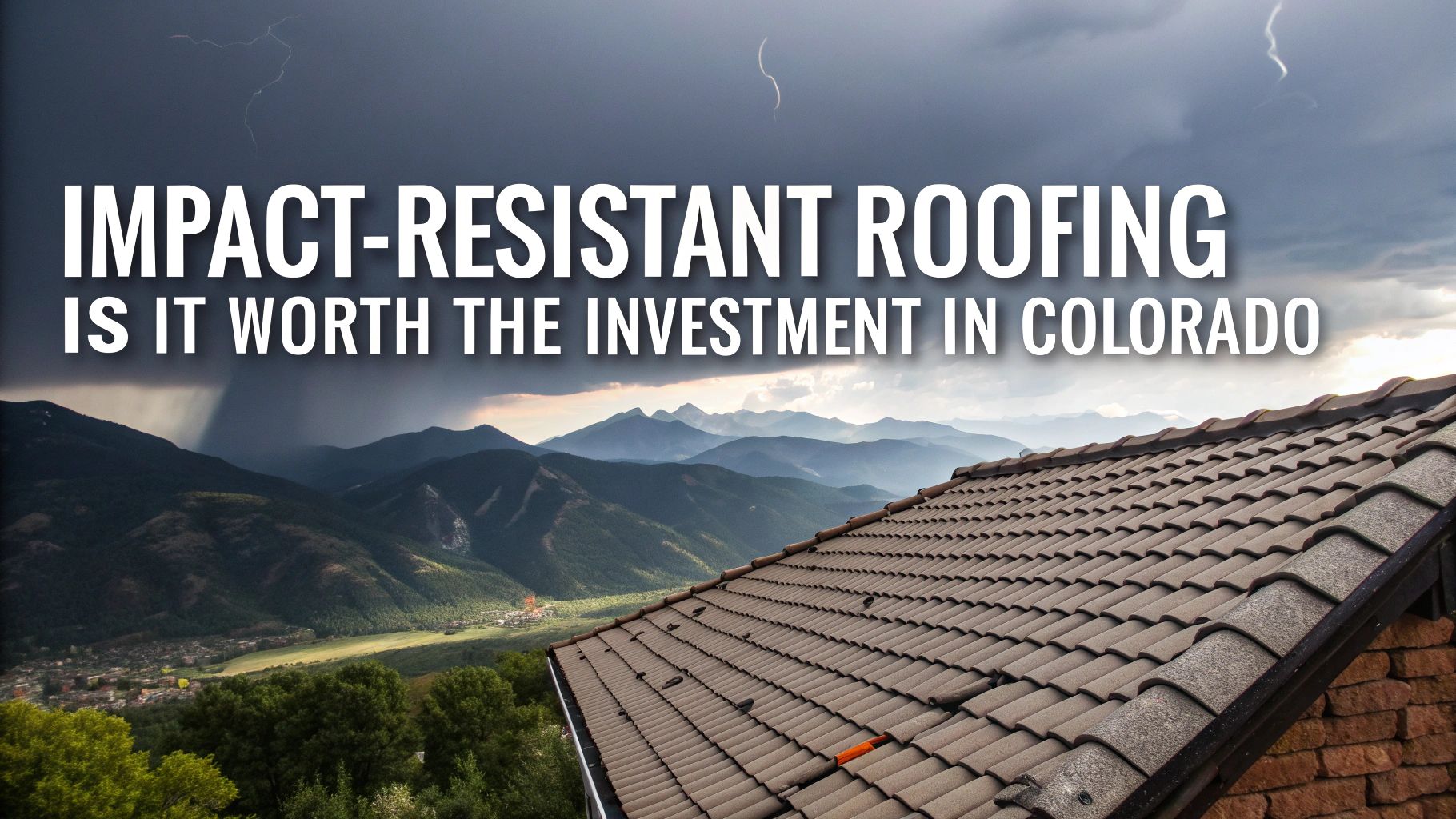Colorado’s extreme weather conditions, from intense hailstorms to heavy snow, make roofing choices particularly important for homeowners.
Impact-resistant roofing materials offer enhanced protection against severe weather damage, potentially saving thousands in repair and replacement costs over time.
This guide examines the benefits, costs, and practical considerations of impact-resistant roofing to help Colorado homeowners make informed decisions about this investment.
What Makes a Roof Impact-Resistant?
Impact-resistant roofing materials undergo rigorous testing to achieve a Class 4 rating – the highest impact resistance classification by Underwriters Laboratories (UL 2218).
- Modified asphalt shingles reinforced with polymers
- Metal roofing systems
- Concrete or clay tiles
- Synthetic slate materials
Benefits for Colorado Homes
Insurance companies often offer premium discounts ranging from 5% to 30% for homes with certified impact-resistant roofing.
- Enhanced protection against hail damage
- Improved resistance to wind-driven debris
- Longer lifespan compared to standard roofing
- Reduced maintenance requirements
- Increased home resale value
Cost Analysis
| Roofing Type | Average Cost per Square (100 sq ft) | Lifespan |
|---|---|---|
| Standard Asphalt Shingles | $100-150 | 15-20 years |
| Impact-Resistant Asphalt | $200-400 | 25-30 years |
| Metal Roofing | $300-700 | 40-70 years |
Installation Considerations
Professional installation by certified contractors is essential for maintaining warranty coverage and ensuring optimal performance.
- Choose contractors certified by roofing manufacturers
- Verify proper ventilation system installation
- Ensure compliance with local building codes
- Check warranty requirements and documentation
Best Times for Installation
Late spring through early fall typically offers the best weather conditions for roof installation in Colorado.
- May through September: Ideal installation months
- Early morning starts during summer
- Weather monitoring for unexpected storms
Making Your Decision
The investment in impact-resistant roofing typically pays off within 5-7 years through reduced maintenance costs and insurance savings.
- Calculate long-term savings vs. initial costs
- Consider local weather patterns
- Review insurance premium reductions
- Evaluate home’s exposure to severe weather
For specific recommendations and quotes, contact local Colorado roofing specialists through the Colorado Roofing Association or call (303) 484-0549.
Maintenance Requirements
Impact-resistant roofs require less frequent maintenance but still need regular inspection and care to maximize longevity.
- Annual professional inspections
- Seasonal gutter cleaning
- Prompt repair of any visible damage
- Documentation for insurance purposes
Environmental Impact
Impact-resistant roofing materials often provide environmental benefits beyond their durability.
- Reduced waste from less frequent replacement
- Many materials are recyclable
- Some options offer enhanced energy efficiency
- Lower carbon footprint over time
Common Installation Challenges
Weather-Related Issues
- Sudden temperature changes affecting materials
- High-altitude considerations
- Wind resistance requirements
Structural Considerations
- Roof pitch and complexity
- Supporting structure capacity
- Existing ventilation systems
Smart Investment for Colorado Living
Impact-resistant roofing represents a strategic investment for Colorado homeowners, offering superior protection against severe weather while providing long-term financial benefits through reduced maintenance and insurance costs.
- Research available materials and warranties
- Consult with multiple certified contractors
- Review local building requirements
- Consider long-term property value impact
Contact your local roofing professional to schedule a consultation and discover the best impact-resistant roofing solution for your Colorado home.
FAQs
- What makes a roof impact-resistant in Colorado?
Impact-resistant roofing materials are typically rated Class 4, the highest impact resistance rating, and are made from materials like modified asphalt, metal, or synthetic polymers designed to withstand hail damage. - How much more expensive are impact-resistant roofs compared to standard roofs?
Impact-resistant roofing materials generally cost 20-30% more than standard roofing materials upfront, with costs ranging from $8,000 to $15,000 for an average-sized home. - Can impact-resistant roofing withstand Colorado’s severe hailstorms?
While no roof is completely hail-proof, Class 4 impact-resistant roofs can withstand hailstones up to 2 inches in diameter and significantly reduce damage from most Colorado hailstorms. - Do insurance companies offer discounts for impact-resistant roofing in Colorado?
Yes, many Colorado insurance companies offer premium discounts ranging from 5% to 30% for homes with certified impact-resistant roofing systems. - What is the average lifespan of an impact-resistant roof in Colorado?
Impact-resistant roofs typically last 25-50 years depending on the material, compared to 15-20 years for standard asphalt shingles in Colorado’s climate. - Are impact-resistant roofs better at handling Colorado’s temperature fluctuations?
Yes, impact-resistant materials are designed to better withstand extreme temperature changes and UV exposure common in Colorado’s high-altitude climate. - What maintenance is required for impact-resistant roofing in Colorado?
Impact-resistant roofs require annual inspections and minimal maintenance, typically including debris removal and checking for loose materials after severe weather events. - Will an impact-resistant roof increase my home’s resale value in Colorado?
Yes, impact-resistant roofing typically increases home resale value by 5-10% in Colorado due to improved durability and reduced insurance costs. - How do impact-resistant roofs perform in Colorado’s heavy snow conditions?
Impact-resistant roofs generally handle snow loads well and are less likely to suffer damage during freeze-thaw cycles common in Colorado winters. - What warranties are available for impact-resistant roofing in Colorado?
Most impact-resistant roofing systems come with 30-50 year manufacturer warranties, often including specific coverage for hail damage.
